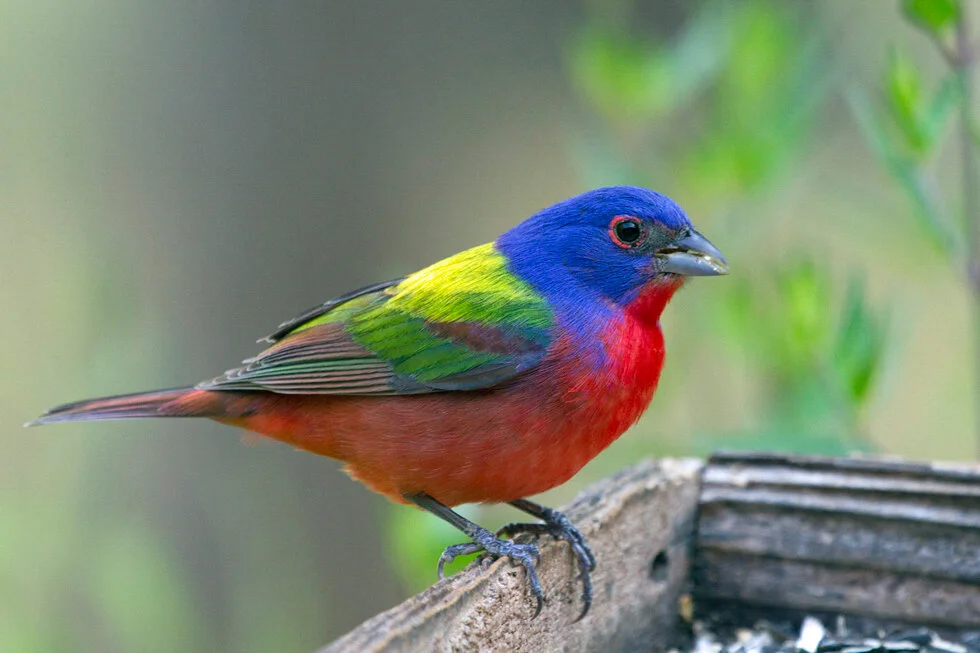Photo: Painted Bunting, Larry Smith/Audubon Photography Awards
A Kaleidoscope of Colors: Rare Painted Bunting Attracts Birders to C & O Canal National Historic Park in Maryland
Jessica Bigger
Painted Bunting, Larry Smith/Audubon Photography Awards
In the early weeks of January, a Painted Bunting (Passerina ciris) was spotted in the brushy grasses and rocks off the towpath of the C & O Canal National Historic Park, between locks 18 and 19. Birders recorded the sighting on eBird and word spread like wildfire throughout social media sites. On Saturday, January 16th more than 1000 people visited the park, and the following day over 100 people returned in hopes of catching a glimpse of our little visitor.
It’s always exciting to seek out rare birds reported by local birders. So, it’s important to follow birding guidelines to respect and ensure the safety of any bird you hope to see or photograph. Remember to stay on designated trails and not approach any birds to ensure you don’t cause them unnecessary stress.
A Painted Bunting is a rare treat in these parts, because it winters in Southern Mexico, throughout Central America, and the Caribbean, as well as the Southern tip of Florida. During their breeding season they spend their time in the coastal southeastern and south-central United States. So, to see one so far north, especially during the winter season, is remarkable.
Painted Buntings are well known for their bright multicolored plumage. The French refer to this bird as nonpareil, meaning “unrivalled”. Even its song is just as magnificent as its plumage. The Painted Bunting has a similar cadence to many warblers. They are so intriguing, that many are caught illegally in Mexico and the Caribbean to be sold as pets.
During the spring and summer months, Painted Buntings hop around in dense understory and brush on the edge of forests. Although you would assume their brilliant colors would make them easy to spot, the brushy vegetation provides them good cover. During the winter season people who live within the species’ winter range can attract Painted Buntings by putting up a bird feeder. They regularly visit feeders to supplement their diet over the winter months.
In addition to searching out bird feeders for seeds, Painted Buntings will also forage for other seeds from bristle grass, pigweed, wood sorrel, spurge, panic grass, St. John’s wort, sedge, dock, pine, rose, wheat and figs. In summer months they become more carnivorous, seeking out grasshoppers, weevils and other beetles, caterpillars, spiders, snails, wasps and flies.
Although Painted Buntings are still abundant throughout the southern United States, Mexico and Central America, scientists and bird advocates are concerned about the effects of climate change and habitat loss to the population.
Recently the National Audubon Society wrote an article about the negative effects of climate change and highlighted a recent study published in the journal Ecological Applications. National Audubon researchers were able to show how climate change has contributed to a major shift in winter and breeding ranges among a large number of bird species. “Climate change is disrupting hundreds of bird species, and thanks to community scientists all across the country, we can visualize these disruptions in real time and plan conservation efforts accordingly,” said Sarah Saunders, PhD, quantitative ecologist at Audubon and lead author of the study, the article quoted.
Twice a year, in the spring and winter, citizen scientists across the country focus on 12 indicator species to help ornithologists get a better picture on the effects of climate change on bird populations across all species. These birds include: White-breasted Nuthatch, Red-breasted Nuthatch, Brown-headed Nuthatch, Pygmy Nuthatch, Western Bluebird, Mountain Bluebird, Eastern Bluebird, Lesser Goldfinch, American Goldfinch, Eastern Towhee, Spotted Towhee and Painted Buntings.
The hope is by following the shifts in the population, scientists can use the data to come up with conservation efforts to combat the effects of climate change on a growing number of bird species at risk of extinction.
Sources:
https://www.washingtonpost.com/dc-md-va/2021/01/03/painted-bunting-great-falls-bird-watchers/
https://www.allaboutbirds.org/guide/Painted_Bunting/overview
https://www.audubon.org/field-guide/bird/painted-bunting


